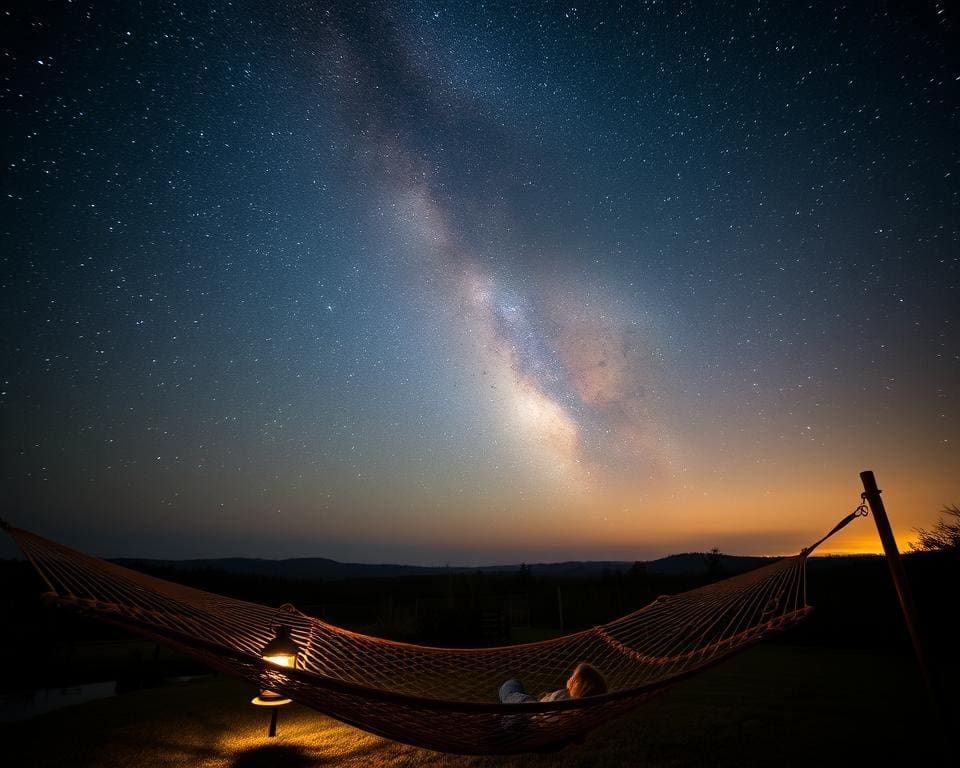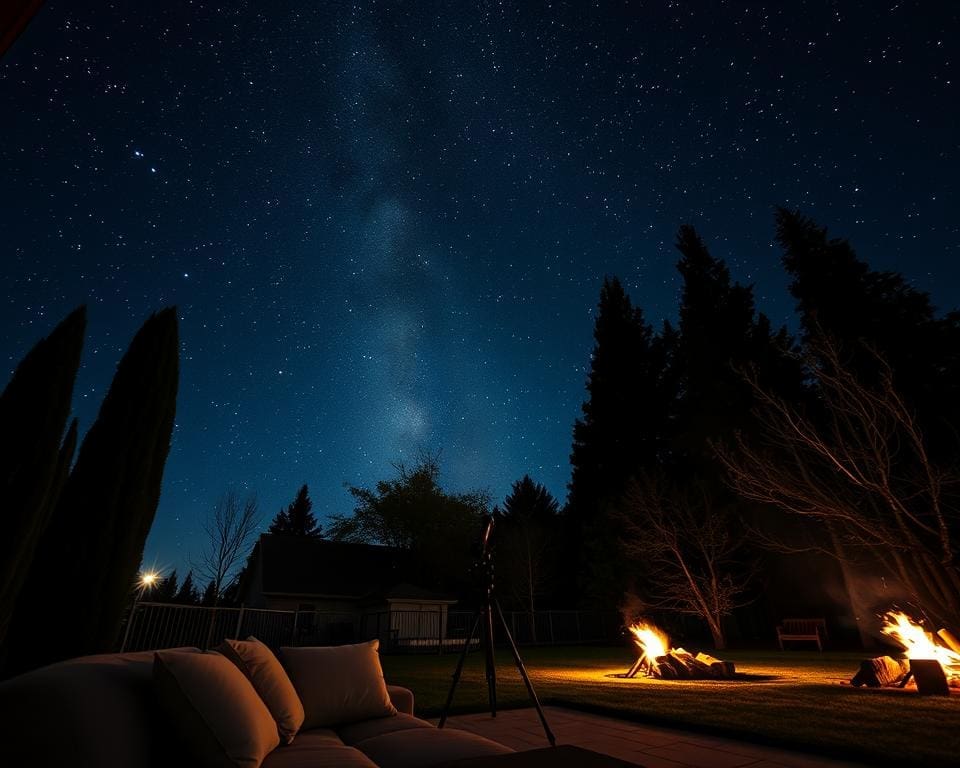Stargazing at home offers a magical experience that allows you to explore the wonders of the night sky without venturing far from your own back garden. Picture this: a clear night, the stars twinkling above, and you comfortably nestled in your outdoor space, discovering constellations and celestial events. Have you tried stargazing in your own back garden? It’s a perfect opportunity to connect with the cosmos, inspiring curiosity and awe right from your backyard.
By embracing back garden stargazing, you eliminate the need for expensive equipment or costly trips to remote locations, making astronomy accessible to all. This article will guide you through the steps to transform your garden into a stargazing haven, encouraging you to immerse yourself in the beauty of the universe from the comfort of home.
Why Stargazing at Home is an Incredible Experience
Stargazing at Home offers an extraordinary opportunity to connect with the universe, all from the tranquility of your own garden. Many assume that one must travel far to witness the beauty of the cosmos, yet a simple glance upwards reveals a breathtaking panorama of stars, planets, and constellations. This unique experience allows individuals to embrace peace and reflect on their place within the vastness of existence.
The Wonders of the Night Sky
The night sky is filled with wonders waiting to be discovered. With the naked eye, one can observe myriad celestial bodies that paint a picture of our universe. Stars twinkle like tiny diamonds scattered across velvet, while planets such as Venus and Jupiter may shine ever so brightly. Spectacular meteor showers and the changing phases of the moon enhance the cosmic spectacle, captivating those fortunate enough to witness them. Adventure lies in the serenity of stargazing at Home, where every glance can offer new revelations.
The Calm of Your Own Space
Experiencing the calm of your own space whilst indulging in stargazing transforms the activity into a soothing ritual. This personal haven enables individuals to escape the relentless pace of everyday life, fostering moments of quiet contemplation. The subtle sounds of nature combined with the breathtaking view create an atmosphere that invites reflection, allowing you to unwind while connecting with the cosmos. Stargazing at Home nurtures not only a sense of wonder but also a profound appreciation for the peacefulness of the universe.

Have You Tried Stargazing in Your Own Back Garden?
Embracing the beauty of the night sky from the comfort of your own garden brings a unique sense of peace and wonder. To achieve this, Making the Most of Your View is essential. A well-thought-out setup can transform your stargazing experience into a delightful adventure.
Making the Most of Your View
Selecting the right spot in your back garden greatly influences your stargazing delights. Seek out an area free from tall trees or buildings that might obstruct your sight of the stars. Take the time to clear away distracting garden features that could take away from the experience. Comfortable seating will enhance your enjoyment; consider using reclining chairs or simple blankets that invite relaxation. Creating a serene spot encourages you to spend more time gazing up at the heavens.
Setting Up a Stargazing Area
Setting Up a Stargazing Area can make your garden an inviting retreat under the stars. Create a cozy atmosphere with blankets, cushions, or even portable hammocks. These elements not only provide comfort but also make it easier to linger and observe celestial wonders. Consider lighting that is soft and subtle, ensuring your stargazing zone remains tranquil. Surrounding yourself with a comforting space encourages connection with the beautiful night sky.
Backyard Astronomy: Tools You Might Need
For an enriching experience in Backyard Astronomy, a selection of essential tools can transform your garden into a stargazing paradise. Whether you’re a seasoned observer or just starting out, having the right equipment enhances your ability to appreciate the wonders of the night sky.
Essential Stargazing Gear
The first step in your stargazing journey involves selecting the right equipment. Investing in quality gear makes all the difference in how you experience celestial phenomena. Consider these essential items:
- Telescopes: A good telescope opens up a world of detail, allowing you to explore distant planets and galaxies.
- Binoculars: These are a portable and budget-friendly option for observing star clusters and lunar landscapes.
- Comfortable Seating: A reclining chair or blanket ensures you stay comfortable during long observation sessions.
- Red LED Flashlights: These light sources preserve your night vision, making it easier to navigate while stargazing.
Useful Apps for Stargazing at Home
In the digital age, technology plays a vital role in enhancing your stargazing experiences. Several apps provide valuable resources for observing the night sky from your own backyard. Popular choices include:
- SkySafari: This intuitive app helps identify stars, planets, and constellations in real-time, making learning enjoyable.
- Star Walk: With interactive sky maps, this app allows users to explore various celestial events and phenomena effortlessly.
- Stellarium: It offers a realistic display of the night sky, making it suitable for all ages and experience levels.
Stargazing Tips for the Perfect Experience
Embarking on a journey of stargazing invites serenity and wonder into your life. To truly appreciate the beauty of the cosmos, certain considerations can enhance your experience significantly. Embracing effective Stargazing Tips will elevate your encounters with the stars.
Choosing the Right Time to Stargaze
Selecting an ideal moment is crucial for a successful stargazing session. Clear nights devoid of clouds provide the best visibility. Aim to stargaze during phases of the new moon, as moonlight can obscure faint celestial objects. Planning your outings seasonally adds another layer; winter nights often yield clarity in the sky.
Understanding Light Pollution
A pivotal factor in optimising your stargazing experience is light pollution. Urban areas frequently cast a haze that diminishes the brilliance of stars. Seek remote locations far from city lights to maximise the visibility of constellations and other astronomical wonders. Identifying parklands or countryside spots away from artificial glow is vital for those passionate about experiencing the full spectrum of the night sky.
Beginner Stargazing Techniques to Explore
For those new to astronomy, Beginner Stargazing can be a thrilling yet daunting endeavour. Familiarising oneself with the fundamental techniques enhances the experience significantly. Understanding the night sky begins with Identifying Basic Constellations, essential guides that spark wonder as you look up. Following that, mastering Using Star Charts Effectively can further enrich your adventures under the stars.
Identifying Basic Constellations
Identifying Basic Constellations serves as a gateway for novice stargazers. Classic patterns like Orion, with its distinctive belt of three stars, and the Big Dipper, a key reference point for the northern hemisphere, stand out against the backdrop of the cosmos. As seasons change, so do the constellations. Familiarity with these celestial formations not only aids in navigation but fills the thrill of discovery.
Using Star Charts Effectively
Using Star Charts Effectively equips beginners with the tools needed to navigate the night sky. These visual aids display star positions and constellation patterns, transforming the seemingly overwhelming expanse into manageable sections. Many apps and printed charts available can help you track star movements and learn their names. Mastering these charts builds confidence, making each clear night an inviting opportunity for exploration and learning.
Making Stargazing Engaging for the Whole Family
Stargazing offers a unique opportunity for families to bond while exploring the wonders of the universe together. Making Stargazing Engaging for the Whole Family can be achieved through a variety of exciting activities tailored for all ages. Not only does this enrich the experience, but it also promotes a collective interest in celestial phenomena.
Fun Activities While Stargazing
Engage everyone in your family with Fun Activities While Stargazing. Consider the following ideas:
- Create constellation crafts using simple materials to represent different star formations.
- Host themed nights where each family member presents facts about a specific planet or star.
- Tell stories or myths associated with constellations, igniting imaginations under the stars.
- Experiment with photography by capturing the night sky, learning about exposure and lighting together.
- Use a telescope or binoculars to discover star clusters and planets, making it a family adventure.
Encouraging Kids to Explore Astronomy
Foster a love for astronomy by Encouraging Kids to Explore Astronomy. Introducing child-friendly apps can make learning interactive and fun. Here are some strategies:
- Organise family stargazing events where kids take part in planning and executing the evening.
- Incorporate games that involve identifying planets and constellations, turning learning into play.
- Set challenges for the family to see who can spot shooting stars first or learn a new constellation each week.
- Utilise engaging documentaries or educational videos to spark curiosity about the cosmos.
Night Sky Viewing: What to Expect Throughout the Year
Embracing the wonders of night sky viewing throughout the year opens up a world of celestial marvels waiting to be discovered in your own back garden. Each season brings its own unique astronomical events, offering stargazers delightful opportunities to witness spectacular shows in the heavens. For example, summer unveils the breathtaking Perseid meteor shower, where you can catch glimpses of shooting stars streaking across the sky, providing a dazzling display for you and your family.
As autumn settles in, keep an eye out for the Orionids, which peak in October and are renowned for their fast and bright meteors. The winter months are not to be overlooked, as the longest night of the year coincides with the winter solstice, creating the perfect backdrop for viewing the magical alignment of planets. The clear, crisp nights offer an ideal setting to gaze upon the constellations that light up the winter sky.
Spring reintroduces the Lyrids meteor shower, activating between mid to late April, representing another wonderful chance for night sky viewing. By planning your stargazing experiences around these significant celestial events, you’ll ensure a year filled with unforgettable moments under the stars. Each season brings new wonders, encouraging a deeper connection to the limitless beauty of astronomy and inspiring you to share your passion with friends and family.









